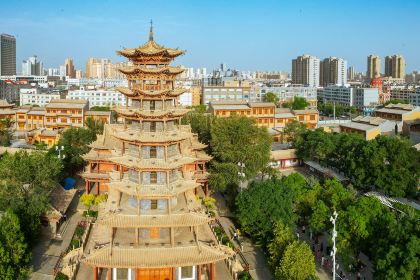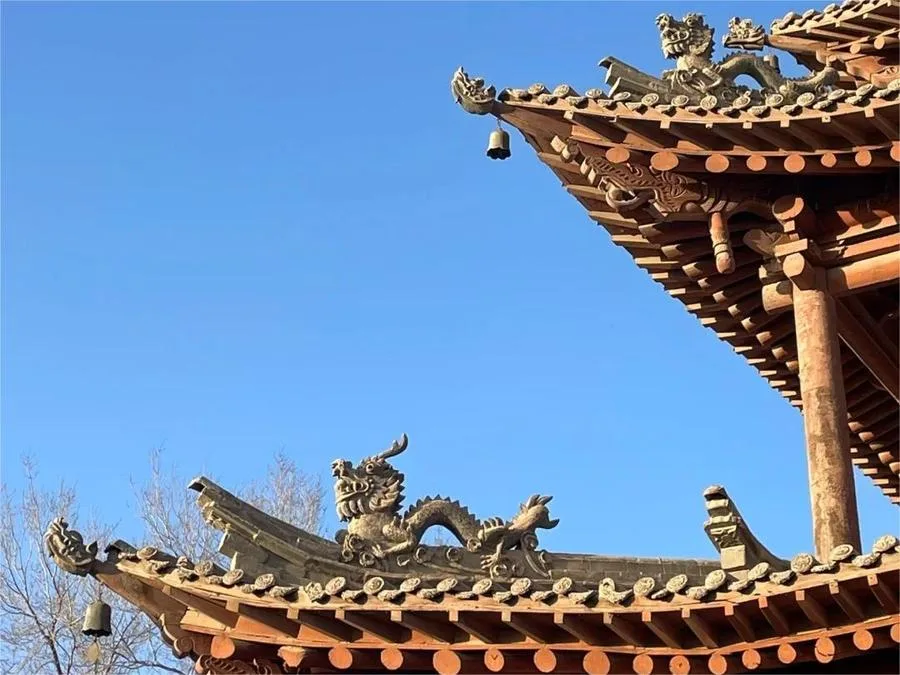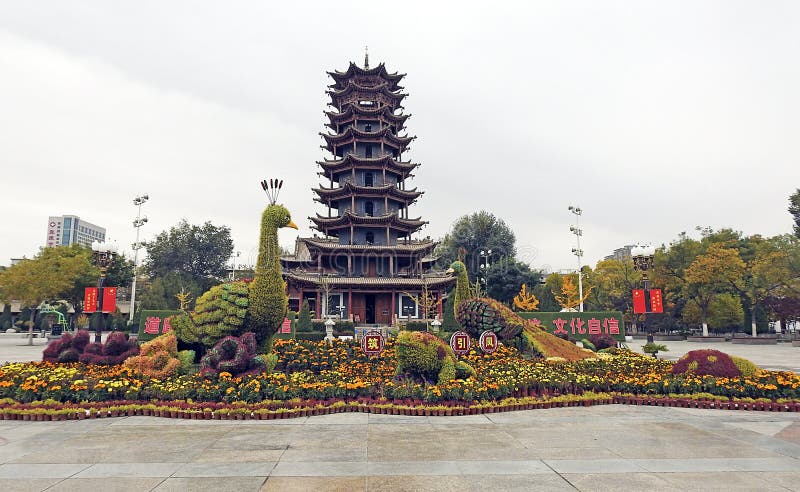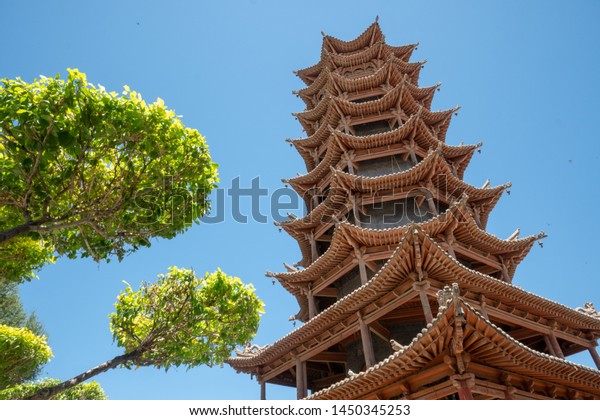Stunning Views and Serenity: Visiting Zhangye Wooden Pagoda

An Essential Guide to Visiting Zhangye Wooden Pagoda
Nestled in the heart of Zhangye City, the Wooden Pagoda Temple—originally known as Wanshou Temple—stands as a remarkable testament to ancient Chinese architecture and spiritual heritage. Dating back over 1,400 years, this stunning structure is not only a feast for the eyes but also a window into the rich history of the region, having been rebuilt and renovated through various dynasties, from the Sui to the Qing. With its intricate wooden craftsmanship and nine stories soaring 32 meters high, the pagoda captivates visitors with its unique post-and-panel construction, drawing admiration from both history buffs and architecture enthusiasts alike.
Surrounded by vibrant parks and activity areas, the Wooden Pagoda Temple invites you to experience the lively spirit of Zhangye, where locals gather for leisure and cultural performances. A visit here is more than just a glimpse at an architectural wonder; it’s an immersion into the heart of a community that celebrates its heritage. Perfectly situated near other notable attractions such as the Giant Buddha Temple and the picturesque Rainbow Mountain, the Wooden Pagoda is a must-see on your journey through this fascinating part of China. Whether you’re looking to appreciate ancient artistry, explore spiritual spaces, or simply enjoy the serene environment, the Wooden Pagoda Temple promises an unforgettable experience.
In This Guide
- An Essential Guide to Visiting Zhangye Wooden Pagoda
- The Rich History and Legends of Zhangye Wooden Pagoda
- Main Highlights: What You Absolutely Can’t Miss
- Planning Your Visit: A Practical Guide
- Tickets: Prices, Booking, and Tips
- How to Get There: A Complete Transportation Guide
- Local Cuisine and Accommodation Nearby
- Frequently Asked Questions
- Final Thoughts on Your Trip
The Rich History and Legends of Zhangye Wooden Pagoda
Nestled in the heart of Zhangye, the Wooden Pagoda, originally known as Wanshou Temple, stands as a testament to over 1,400 years of history and craftsmanship. Built in 582 during the Sui Dynasty, this remarkable structure has witnessed the rise and fall of dynasties and has been a silent observer of the cultural evolution of the region.
The pagoda’s significance was further solidified in 639 when Emperor Taizong of the Tang Dynasty ordered a renovation led by the esteemed Weichi Jingde. This act not only reflects the imperial recognition of the pagoda’s importance but also marks the beginning of its journey as a cherished cultural landmark. The Wooden Pagoda continued to thrive through the ages; in the early 15th century, it underwent substantial expansion under the guidance of Monk Manzhen during the Ming Dynasty, who collected alms to support the temple’s growth.
However, like many historical sites, the Wooden Pagoda faced periods of decline. In 1685, during the Qing Dynasty, Gansu Provincial Commander-in-Chief Sun Sike visited and renovated the temple, but the structure was later damaged. It wasn’t until 1926 that a significant rebuild took place, ensuring the pagoda’s survival for future generations to admire.
The architectural marvel stands at 32 meters tall, featuring nine intricately designed stories. What sets it apart is its unique post-and-panel construction method, which utilizes no rivets; instead, an ingenious system of crisscrossed brackets, beams, and columns provides structural integrity. Surrounding the pagoda are beautifully carved granite fences, depicting auspicious symbols such as dragons and phoenixes, which add to its cultural richness.
In recent years, the Wooden Pagoda has been restored and integrated into a larger architectural complex that includes the Buddhist Classics Hall and the main hall, further enhancing its allure for visitors. Today, the pagoda remains a vital part of Zhangye’s identity, not just as a historical monument but as a vibrant space where locals and tourists alike gather to appreciate its beauty and significance.
The Wooden Pagoda is not merely an architectural feat; it is a living repository of stories, legends, and the interplay of faith and culture throughout Chinese history. Its enduring presence continues to inspire awe, making it a must-visit for anyone exploring the depths of Zhangye’s rich heritage.

Zhangye Wooden Pagoda.
Main Highlights: What You Absolutely Can’t Miss
When visiting Zhangye Wooden Pagoda, also known as Wanshou Temple, there are several highlights that you absolutely cannot miss. This ancient structure, steeped in history and cultural significance, offers an enriching experience for international travelers. Here’s what to look out for:
Architectural Marvel
One of the most striking features of the Zhangye Wooden Pagoda is its stunning post-and-panel construction. Standing at 32 meters tall with nine stories, the pagoda is a fine example of ancient Chinese craftsmanship. The intricate connections of wooden beams and columns, which rely on crisscrossing rather than rivets, showcase the ingenuity of ancient builders. Be sure to admire the beautifully carved granite boulder fences adorned with auspicious motifs like dragons and phoenixes that surround the pagoda.
Journey Through History
The Wooden Pagoda Temple is not just an architectural wonder; it has a rich history dating back over 1,400 years. Originally built during the Sui Dynasty in 582, it has undergone several renovations, most notably by Emperor Taizong of the Tang Dynasty and later during the Ming and Qing Dynasties. Each layer of the pagoda tells a story, reflecting the evolution of architectural styles and religious practices through the centuries.
Scenic Surroundings
Nestled in the heart of Zhangye, the pagoda is surrounded by a serene park area, providing a tranquil escape from the bustling city. Visitors often gather here to exercise, practice tai chi, or simply enjoy the peaceful ambiance. If you visit on a weekend, you might even catch a local dance performance, showcasing vibrant costumes and traditional movements that reflect Central Asian influences.
Climbing the Pagoda
For those seeking a bit of adventure, climbing the Wooden Pagoda is a must. While there is a nominal fee to access the interior, the panoramic views from the upper levels are well worth it. From the top, you can take in stunning vistas of the city, the surrounding landscape, and even glimpse the majestic Rainbow Mountains in the distance.
Nearby Attractions
Make sure to allocate time to explore nearby attractions, such as the Giant Buddha Temple and the Zhangye UNESCO Geopark, famous for its colorful Danxia landforms. These sites can easily be visited in tandem with the Wooden Pagoda, allowing for a rich day filled with cultural and natural wonders.
Conclusion
Zhangye Wooden Pagoda is a treasure trove of history, architecture, and local culture. Whether you’re captivated by its intricate design, intrigued by its storied past, or simply looking to enjoy a peaceful day in the park, this pagoda is a destination that promises a memorable experience. Don’t miss the opportunity to immerse yourself in the beauty and heritage of this remarkable site during your travels in China.

Zhangye Wooden Pagoda.
Planning Your Visit: A Practical Guide
When planning your visit to the Zhangye Wooden Pagoda, also known as Wanshou Temple, you’ll discover a unique blend of history, culture, and stunning architecture that is sure to enrich your travel experience. Here’s a practical guide to help you make the most of your visit.
Getting There
Location:
The Wooden Pagoda is situated in the heart of Zhangye City, Gansu Province, at Xianfu South Street. This central location makes it easily accessible by foot from other nearby attractions, such as the Giant Buddha Temple.
Transportation:
– By Air: The nearest airport is Zhangye Ganzhou Airport, which has domestic flights from major cities like Beijing and Xi’an. From the airport, you can take a taxi or a shuttle bus to the city center.
– By Train: Zhangye is well-connected by train to various parts of China. The train station is a short taxi ride away from the pagoda.
– Public Transport: Local buses and taxis are available and are a convenient way to navigate the city.
Opening Hours and Admission
Opening Hours:
The Wooden Pagoda is open daily from 8:00 AM to 6:00 PM. It’s advisable to arrive early to avoid crowds, especially during weekends and holidays.
Admission Fee:
While the specific admission fee can vary, it’s generally around CNY 20 to enter the pagoda. This fee allows you to explore the pagoda and its surrounding areas.
What to See
-
The Pagoda: At 32 meters high with nine stories, the Wooden Pagoda is a masterpiece of ancient Chinese architecture. Note the intricate workmanship, where beams and columns are interlocked without nails—a testament to the skills of ancient builders.
-
Surrounding Area: The pagoda is nestled within a small park, making it a lovely spot to relax and take photos. On weekends, you might witness local residents engaging in exercises or traditional dances, adding to the vibrant atmosphere.
-
Adjacent Attractions: Don’t miss the nearby Giant Buddha Temple and the Zhangye Museum, both within walking distance. This allows you to immerse yourself fully in the rich cultural heritage of the area.
Tips for Your Visit
-
Climb the Pagoda: If you’re feeling adventurous, consider climbing the pagoda. The winding corridors and multiple levels provide a unique perspective of the structure and the surrounding landscape. Check for any additional fees that may apply.
-
Respect Local Customs: As the Wooden Pagoda is a religious site, dress modestly and be respectful of the local customs. Avoid loud noises and disruptive behavior.
-
Photography: The pagoda and its surroundings are picturesque, making it a great spot for photography. Early morning or late afternoon light can provide the best conditions.
-
Stay Hydrated and Wear Comfortable Shoes: Exploring the pagoda and its surroundings may require some walking, so wear comfortable shoes and bring water, especially in warmer months.
Nearby Dining Options
After your visit, consider dining at one of the local restaurants nearby. Popular choices include:
– Xiao LaJiao (Szechuan cuisine) – approximately 0.4 miles away.
– Liang Mao Restaurant – known for its local dishes, about 1 mile from the pagoda.
Conclusion
With its historical significance and beautiful surroundings, the Zhangye Wooden Pagoda is a must-visit for anyone traveling to Zhangye. By following this guide, you can ensure a smooth and enjoyable experience that captures the essence of this remarkable cultural landmark. Don’t forget to immerse yourself in the local atmosphere and take the time to explore the vibrant city of Zhangye!

Zhangye Wooden Pagoda.
Tickets: Prices, Booking, and Tips
Visiting the Zhangye Wooden Pagoda, also known as Wanshou Temple, is a journey into a rich historical tapestry, and securing your tickets is the first step in this adventure. Here’s everything you need to know about ticket prices, booking options, and some helpful tips for your visit.
Ticket Prices
The entrance fee for the Zhangye Wooden Pagoda is typically around CNY 20 (approximately $3 USD). This modest fee grants you access to the pagoda and its surrounding grounds, allowing you to soak in the historical ambiance and beautiful architecture.
Booking Options
While tickets can often be purchased on-site, especially during non-peak seasons, it’s advisable to book in advance during busy travel periods or Chinese public holidays. Tickets can be booked through various online platforms, travel agencies, or even at your hotel’s concierge desk.
Tips for a Seamless Experience
-
Check Opening Hours: The Wooden Pagoda is open from 8:00 AM to 6:00 PM. Arriving early can help you avoid crowds and enjoy a more peaceful experience.
-
Combine Visits: The pagoda is conveniently located near other attractions like the Giant Buddha Temple (Dafo Temple). Consider planning your itinerary to visit these sites back-to-back, as they are within walking distance of each other.
-
Climbing the Pagoda: If you’re feeling adventurous, you can climb to the upper levels of the pagoda for a small additional fee. The view from the top provides a stunning perspective of Zhangye’s skyline and the surrounding area.
-
Cultural Events: Keep an eye out for local cultural performances and activities in the park surrounding the pagoda. These events, often featuring traditional dances, can enhance your visit and provide insight into the local culture.
-
Photography: The pagoda is a picturesque site, especially around sunrise or sunset. Bring your camera to capture this architectural gem against the backdrop of the changing sky.
-
Plan for the Weather: Zhangye experiences a range of weather conditions, so check the forecast and dress appropriately. Comfortable shoes are recommended, especially if you plan to walk around the area.
By following these guidelines, you’ll be well-prepared to enjoy the magnificence of the Zhangye Wooden Pagoda and make lasting memories in this historic site. Happy travels!
How to Get There: A Complete Transportation Guide
Reaching the Zhangye Wooden Pagoda, also known as Wanshou Temple, is an adventure in itself, offering various transportation options that cater to different travel styles and budgets. Below is a guide to help you navigate your way to this historical gem located in the heart of Zhangye, Gansu Province, China.
By Air
Zhangye Ganzhou Airport (YZY) is the nearest airport to the Wooden Pagoda, located about 30 kilometers (approximately 18 miles) from the city center.
- Getting to Zhangye City from the Airport:
- Taxi: The quickest and most convenient option. Taxi rides to the city center take around 30 minutes.
- Airport Shuttle: Check for any available shuttle services that might offer transport to major hotels or landmarks in Zhangye.
By Train
Zhangye is well-connected to major cities by train, making it an accessible destination for travelers.
- High-Speed Trains:
-
If you’re coming from Beijing, Xi’an, or Lanzhou, high-speed trains are a comfortable option. The train station is located in the city and is about a 10-15 minute taxi ride from the Wooden Pagoda.
-
Regular Trains:
- For those on a budget, regular trains serve the area as well. Just ensure to check the schedules in advance, as they may vary.
By Bus
Long-distance buses are another viable option, particularly if you are traveling from cities like Lanzhou or Jiayuguan.
- Bus Stations:
- Zhangye has a central bus station where you can catch buses from various locations. Once you arrive, the Wooden Pagoda is about a 15-minute taxi ride away, or you can opt for local buses or rideshare services.
Local Transportation
Once in Zhangye, getting to the Wooden Pagoda is straightforward:
-
Walking: If you’re staying in the city center, the pagoda is within walking distance from several attractions, including the nearby Dafo (Buddha) Temple.
-
Taxi: Taxis are readily available throughout the city and are an affordable option for getting around. A typical ride to the Wooden Pagoda will cost a few yuan.
-
Public Buses: Look for local bus routes that stop near the pagoda. It’s an economical way to navigate the city, although it may take longer depending on the route.
Tips for Your Visit
-
Check Opening Hours: The Wooden Pagoda is open from 08:00 to 18:00, so plan your visit accordingly.
-
Cultural Etiquette: As a site of religious significance, remember to be respectful while visiting.
-
Nearby Attractions: Consider combining your visit to the Wooden Pagoda with nearby attractions like the Giant Buddha Temple or the Zhangye UNESCO Geopark, known for its stunning Rainbow Mountains.
With multiple transportation options at your disposal, getting to the Zhangye Wooden Pagoda is convenient and user-friendly, allowing you to immerse yourself in the rich history and culture of this remarkable site. Enjoy your journey!

Zhangye Wooden Pagoda.
Local Cuisine and Accommodation Nearby
Exploring the Zhangye Wooden Pagoda is not just about soaking in the stunning architecture and rich history; it’s also an opportunity to indulge in local cuisine and find comfortable accommodations nearby. Here’s a guide to help you make the most of your visit.
Local Cuisine
When it comes to dining, Zhangye offers a variety of culinary delights that reflect the region’s unique culture. Here are a couple of eateries you shouldn’t miss:
-
Xiao LaJiao (小辣椒): Located just 0.4 miles from the Wooden Pagoda, this Szechuan restaurant is known for its spicy dishes and vibrant atmosphere. Try their signature hot pot or the mouth-watering spicy chicken, which are local favorites.
-
Liang Mao Restaurant (凉毛饼): About a mile away, this restaurant specializes in traditional Chinese fare with a local twist. Their handmade noodles and dumplings are highly recommended, and the cozy setting makes it a perfect spot for a relaxing meal after a day of sightseeing.
Nearby Accommodations
After indulging in the local flavors, you’ll want a comfortable place to rest. Here are some accommodation options that offer convenience and quality:
-
Zhangye Huayi Hotel (张掖华懿酒店): This hotel is located only a short distance from the Wooden Pagoda and offers modern amenities, including complimentary Wi-Fi and breakfast. The staff is friendly, and the rooms are clean and comfortable, making it a great choice for travelers.
-
Zhangye International Hotel (张掖国际酒店): A little further out but still within easy reach, this hotel provides a balance of luxury and affordability. With spacious rooms and an on-site restaurant serving both Western and Chinese dishes, it’s an ideal base for exploring the city.
-
Jinjiang Inn (锦江之星): A budget-friendly option located near the city center, this hotel is known for its excellent service and comfortable accommodations. It’s perfect for travelers looking to save while still enjoying proximity to major attractions.
Final Thoughts
Combining a visit to the Zhangye Wooden Pagoda with local dining and comfortable lodging can enhance your travel experience. Whether you’re savoring the spicy flavors of Szechuan cuisine or unwinding in a cozy hotel room, you’ll find that Zhangye has much to offer beyond its stunning historical sites. Enjoy your culinary and cultural journey in this charming city!

Zhangye Wooden Pagoda.
Frequently Asked Questions
Frequently Asked Questions about Zhangye Wooden Pagoda
-
What is the best time to visit the Zhangye Wooden Pagoda?
The Wooden Pagoda is open daily from 08:00 AM to 06:00 PM. For a more peaceful experience, consider visiting early in the morning or later in the afternoon. The surrounding area also comes alive with local activities on weekends, adding to the experience. -
How do I get to the Wooden Pagoda in Zhangye?
The Wooden Pagoda is conveniently located on Xianfu South Street in the center of Zhangye. You can easily reach it by taxi, public bus, or even on foot if you’re staying nearby. It’s also close to other attractions such as the Dafo Temple, making it a great stop on your itinerary. -
Is there an entrance fee to visit the Wooden Pagoda?
Yes, there is a small entrance fee to access the Wooden Pagoda. The fee may vary, so it’s a good idea to check locally when you arrive. Be sure to bring some cash, as not all places may accept cards. -
Can I climb the Wooden Pagoda?
Yes, visitors can climb up the Wooden Pagoda for a fee. The pagoda has multiple levels, and climbing to the top offers a unique view of the surrounding area. However, if you choose not to climb, the architecture and craftsmanship can still be appreciated from the ground. -
What should I wear when visiting the Wooden Pagoda?
Comfortable footwear is recommended, especially if you plan to climb the pagoda. Additionally, since Zhangye can experience varying weather, dressing in layers is advised. Don’t forget sun protection if you’re visiting during the warmer months! -
Are there any nearby attractions to visit after the Wooden Pagoda?
Absolutely! The Wooden Pagoda is within walking distance of several attractions, including the Dafo Temple and the Zhangye Museum. The beautiful Rainbow Mountains of Zhangye are also a must-visit for stunning natural scenery, though they require a bit more travel. -
Are there any dining options close to the Wooden Pagoda?
Yes, you’ll find various dining options nearby, ranging from local eateries to more casual dining places. Be sure to try some local Gansu cuisine while you’re in the area for a complete experience! -
Is the Wooden Pagoda suitable for families with children?
Yes, the Wooden Pagoda is family-friendly. The surrounding park area provides a great space for kids to play and explore. However, ensure that younger children are monitored, especially if you choose to climb the pagoda.
Final Thoughts on Your Trip
As you reflect on your journey to Zhangye, let the memories of the Wooden Pagoda linger in your mind like the gentle whispers of history. Standing tall at 32 meters, this architectural marvel is not just a testament to ancient craftsmanship but also a bridge connecting the past to the present. The intricate wooden structure, with its beautifully carved granite fences, invites you to explore its layers, each telling a story of resilience and cultural significance.
Surrounded by the vibrant life of Zhangye, where locals gather to dance and celebrate their heritage, the pagoda offers a serene escape amidst the bustling city. Take a moment to soak in the atmosphere, whether it’s the sound of laughter in the nearby park or the spiritual tranquility that emanates from the temple grounds.
Visiting the Wooden Pagoda is more than just a sightseeing stop; it’s a chance to connect with the heart of Zhangye—a city rich in history and culture. As you depart, carry with you the spirit of this remarkable place, and let it inspire your travels ahead. Whether you return to explore more of Gansu Province or venture further along the Silk Road, let the echoes of the past guide you toward new adventures. Safe travels!